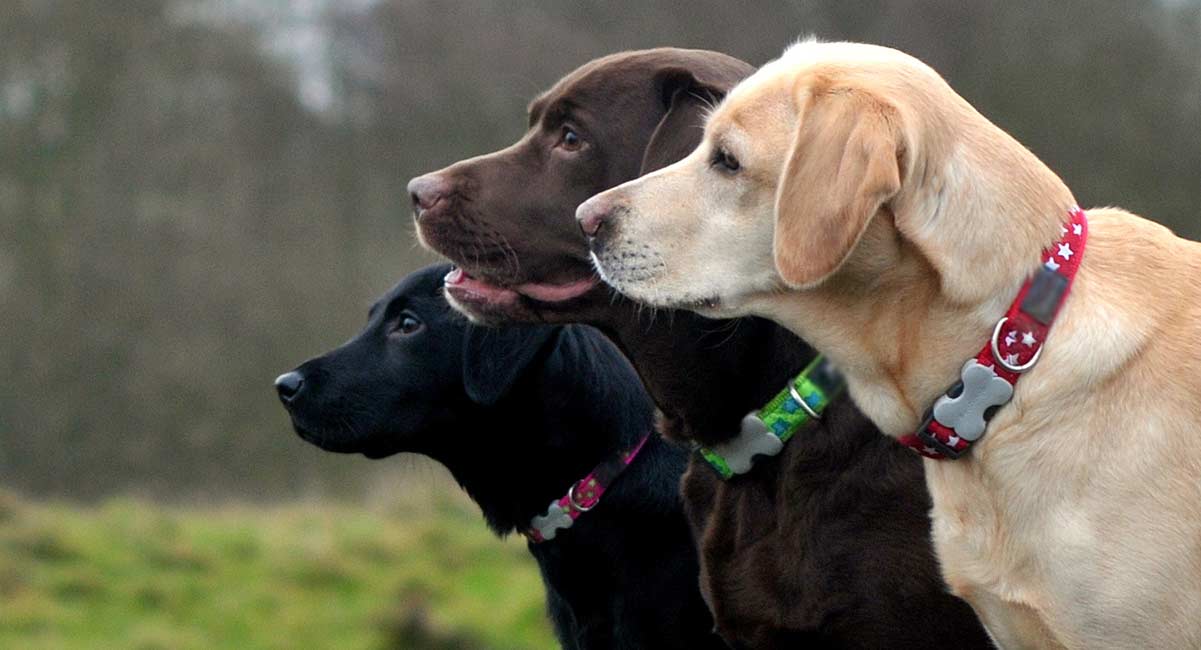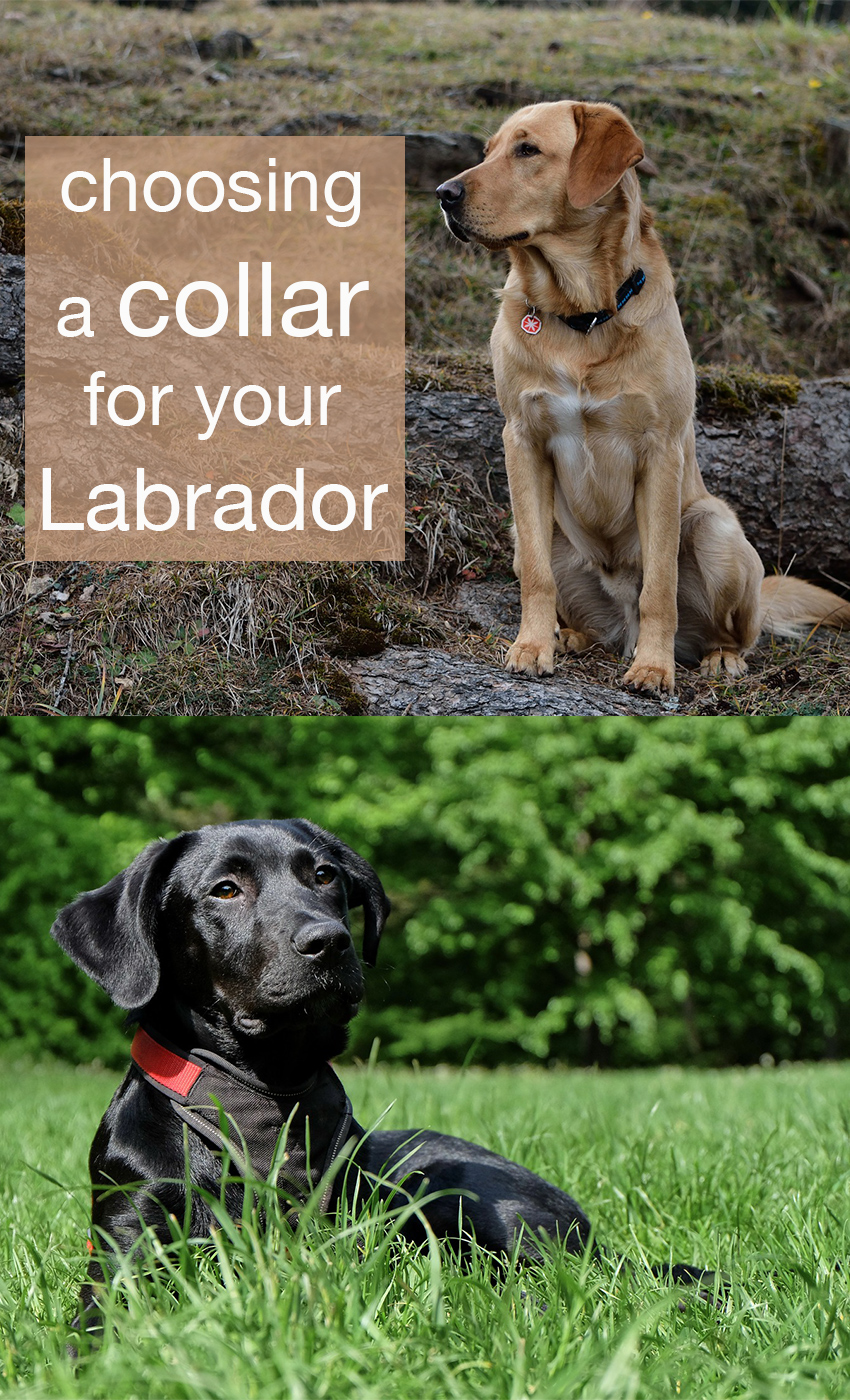Labrador Collar Sizes, Styles and Choices
The best Labrador collar will fit comfortably, be durable and help your dog stay safe. Today I’ll share top tips to help you choose the right collar for your dog. I’ll share the pros and cons of the wide range of materials, styles, and designs available. And show you how to choose the right size Labrador collar for your pup or adult dog.
- Labrador collars and the law
- Personalized dog collar safety
- Training collars for Labradors
- Labrador collar size and fit
- Harnesses for Labradors
It is all rather bewildering, but there is no need to worry! This is where you can find the answers to those questions, and get some ideas and inspiration too.
*The products linked in this article were carefully selected by The Labrador Site. If you decide to purchase using the links provided, we may earn a small commission on that sale. This is at no extra cost to you.
Labrador Dog Collars and the Law
In many parts of the world, dogs must legally wear a collar when out in public. For your dog collar to meet legal requirements, you’ll probably need to have an identity tag. This is usually a disk attached to the collar, with your phone number and name on it.
Collars can display IDs in a number of different ways. Some collars come with a brass or stainless steel plate* (paid link)attached to the surface, others have a metal ring for you to attach a tag onto. Others will embroider the ID into fabric(paid link)* or tool it into leather. These last two methods are most often used for adding the dog’s name, whereas a metal plaque or disk is usually a better way to display a telephone number and your own name.
Are Personalized Dog Collars Safe?
Some pet parents really like the idea of having their dog’s name written clearly on the surface of the collar. But others feel that this is a dangerous thing to do. The concern in the past has been that knowing a dog’s name might make him an easy target for thieves. But most dogs are always supervised when outdoors, and many dogs are also microchipped so proof of ownership is more easily accomplished.
Unless your dog is very friendly and spends time outdoors on his own, having his name on his collar is unlikely to put him at risk.
Collars as a Fashion Statement
A collar is the traditional way of attaching a restraint to a dog, for the purposes of keeping him safe. Before harnesses were invented this was an essential feature of life in a modern world, where cars and other hazards are everywhere. But in many homes and families, a collar has become something of a fashion statement too. A whole industry has arisen to meet the demand for different fabrics and styles.
Instead of going out to buy a collar that looks like everyone else’s, you can now choose something charming or exciting. One that suits your dog’s personality as well as your own. But before we look at the choice available, and discuss how to get the right size collar for your dog, let’s just quickly mention training collars.
Training Collars for Labs
Many people look on a collar, as an aid to training their dog how to walk on a leash. A way to get their dog to tread along nicely next to them, without dragging or pulling them along. They want to choose a collar that will best help them in this goal. And quickly discover that putting pressure on a standard collar doesn’t stop their dog from ignoring their pleas to ‘walk nicely’.
Several different types of collar have been invented in order to enable dog owners to ‘correct’ their dogs when they pull. Prong collars and pinch collars have been designed that are uncomfortable and even painful when a dog leans into them. The problem of course, is that pulling is often very rewarding for a dog (he gets nearer to the destination he likes). So collars usually have to be quite painful if they are to successfully stop the pulling.
Collars that can be used to pinch and choke dogs, are becoming less popular, as more and more dog owners want to train without using unpleasant aversives. And fortunately there are now excellent ways of teaching a dog to walk nicely without using collars at all.
And in the meantime you might find it helpful to have a strong pulling dog fitted with a body harness that will give you more control without damaging his neck. Before you set off on a Labrador collar shopping expedition, you will need to think about sizes. And to know your Labrador neck size.
Labrador Collar Size
Not all collars are made in sizes large enough for an adult Lab. And one adult Lab will not have the same neck size as another. So you do need to whip out your tape measure in order to avoid disappointment
Both my Labs have an 18 inch neck. They are medium build slim Labradors. A classic stocky English Lab is likely to have a bigger neck so I’d say allow for 20 inches. But it really is best to measure. If you find it difficult to keep your dog still, just get someone to dip their fingers in some butter and let the dog lick it off while you take his measurements!
Collars for adult Labs are usually about an inch wide – this allows enough space for a small ID plaque if desired.
What Size Collar for a Lab Puppy?
Puppies grow so fast that your Lab’s baby collar won’t fit him for very long. You’ll need to buy a collar at least 9 inches long, some puppies will need to start at 10 or more inches. If you buy a puppy collar two or three inches longer than this it will last him a few weeks.
Puppy collars are usually narrower than adult collars, half an inch is fine. And they come in some very cute designs. We have put together a collection of our favorite puppy collars to inspire you! So what kind of collar should you buy? Leather? Fabric? Metal? Let’s take a look.
Which Labrador Collar Style?
We recommend that you buy your Labrador a flat collar with a buckle fastener. We don’t recommend metal ‘choke chain’ collars or even half check (see training collars above). Leather ones, like this Traditional Leather Collar(paid link)* are fine, but so are many strong man-made fabric collars.

You can choose one to suit your taste and wallet. Leather and fabric collars are great, but they can get a bit ‘smelly’ as they age. Especially if your Lab likes to swim.
You can buy waterproof collars made from synthetic polyurethane type materials. Waterproof collars tend to resist odor and are easy to clean. They often come in striking bright colors – we love them and think they look cool!
Does my Dog’s Collar Fit?
It is normal to worry whether or not your dog’s collar is too tight or too loose. Your dog’s collar should be a snug fit without compressing his airway or rubbing his skin. But not so loose that he can back out of it. You should be able to fit two or three fingers under it quite easily, but not much more. A collar that is too loose can be slipped by a lively dog very easily. Some dogs are experts at backing out of collars and you definitely don’t want that happening on the edge of a busy highway!
It is also worth considering alternative forms of restraint. Especially for puppies and lively young dogs that can get very sore necks if leashed to a collar.
Buying a Harness
The breadth of choice in body harnesses for dogs has burgeoned in the last couple of years as people discover how great they are. A body harness is an excellent way to restrain a young dog that has not been taught to walk to heel. It has several advantages over a collar. It is almost impossible for the dog to slip out of. And most importantly, a puppy that wears a harness is not learning to lean into or pull, on his collar.
My favorite is the Freedom harness(paid link)* which has front and back attachments.

Affiliate link disclosure: Links in this article marked with an * are affiliate links, and we may receive a small commission if you purchase these products. However, we selected them for inclusion independently, and all of the views expressed in this article are our own.

Free Labrador Updates!
Get my training tips, news, reviews, and the latest from The Labrador Site delivered to your inbox





I just got my 4 yr old lab a 1 1/2 inch wide collar l feel like it’s to wide ,what do you think?
Hi Debra – it’s a little wider than average, but I would let your dog guide you as to whether it’s comfortable. If they ignore the collar completely when it’s on, and you can slide two fingers comfortably under the collar all the way around, it’s most likely fine 🙂
If my dog is outside because I have no fence and did tends to chase people I cannot find a collar to hold while she is tied. Either eases or rolls around on the ground until collar comes off. Or pulls hard enough to break ring from collar. What type of collar would be hard to break or slide off black lab? Getting frustrating because I’ve bought all types
Following reading the above I got an easy walk harness and my puller was transformed, Highly recommend one of these as it does make for an easy walk. This has helped me as I have two older plodders and a young ex puller to walk and having arthritis has made taking the dogs out much more easy on my joints.
Glad you found the harness helpful Graham 🙂